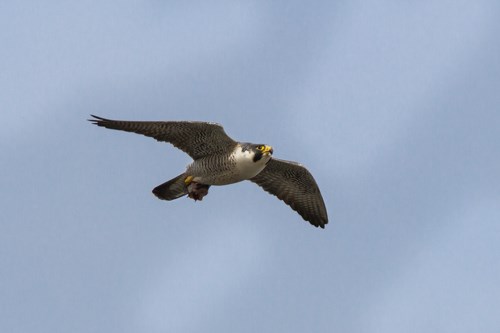
NPS/Gordon Dietzman IntroductionThe peregrine falcon is a skilled predator, feeding almost exclusively on other birds such as ducks, starlings, pigeons, and songbirds. At times it may even prey on birds much larger than itself! The peregrine is arguably the fastest animal on the planet. When it stoops--dives on prey--a peregrine may reach speeds of up to 200 mph. Despite the ability to reach these speeds, a peregrine, like other birds, probably uses no more speed than what is necessary to catch up to its prey and attack it. As a result, this speedy bird only occasionally reaches top speed; most dives are closer to 100 mph. The ability to fly this fast, however, places unusual demands on the bird. Eyesight has to be very sharp and must be able to judge distances to prey accurately to precisely intercept it in the air. The nares, or nostrils, also must regulate air intake so the bird can breathe at high speeds. (Small bony projections help slow air as it enters the nares.) Peregrines are magnificent birds and were once considered endangered. Fortunately, although still uncommon, they have staged a comeback largely due to reintroduction programs, but these top predators also greatly benefited from the ban on DDT. Minnesota had an estimated 50 pairs that raised 93 young in 2008. Peregrines were removed from the Federal Endangered Species list in 1999, but remain on the Minnesota Threatened Species list. Fascinating Facts
Identification
| |
Last updated: February 25, 2022
